If you’re looking to jazz up your space with some miniature greenery, I suggest considering Mame and Shohin bonsai! These little gems, like Ficus retusa or adorable Azaleas, pack a punch in style. Ever thought about creating a Zen garden or grouping multiple bonsai for a forest effect? Don’t forget some quirky accessories or a sleek ceramic pot to elevate your display! Curious about how to care for these beauties? Let’s explore more bonsai magic together!
Quick Takeaways
- Choose compact varieties like Mame or Shohin bonsai for limited spaces, as they thrive in small pots and require careful maintenance.
- Incorporate popular species like Ficus retusa and Fukien Tea for attractive indoor greenery with minimal care needs.
- Create unique displays using artistic ceramic pots and natural elements like stones or moss to enhance the aesthetic appeal of your bonsai.
- Utilize monthly fertilizing and proper pruning techniques to maintain the health and shape of your bonsai, ensuring they flourish indoors.
- Consider the symbolism of different bonsai species to personalize your space, fostering mindfulness and harmony in your home.
Mame Bonsai and Shohin Bonsai
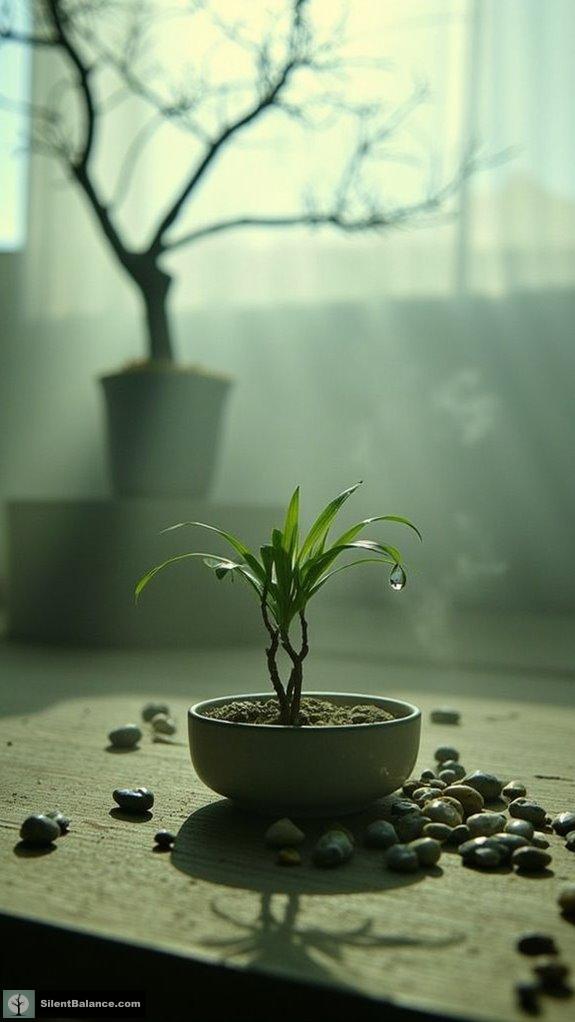
When diving into the enchanting world of bonsai, you’ll often find yourself mesmerized by two delightful styles: Mame and Shohin bonsai.
Mame bonsai, tiny wonders ranging from 2 to 6 inches, fit right in the palm of your hand. They need meticulous care—a little water goes a long way, but overdoing it? That’s a big no-no! Mame bonsai are often cultivated in small pots with careful pruning to create intricate scenes within confined spaces. This style of bonsai embodies spiritual significance in Japanese culture, representing harmony between nature and miniature art.
Then there’s Shohin, which, while still miniature at up to 8 inches, offers a touch more complexity. Think of it as the oversized cousin to Mame, allowing a bit more branching drama.
But let’s be real: whether you’re crafting a mini forest or a lone tree, it’s all about showcasing nature’s beauty.
Isn’t it just charming how a little greenery can transform your life?
Popular Miniature Tree Species

Every bonsai aficionado knows that choosing the right tree species is half the magic behind these miniature marvels.
If you’re leaning towards broadleaf evergreens, consider Ficus retusa, with its glossy leaves that seem to smile year-round.
Or how about the charming Fukien Tea? It’s like a tiny work of art, thriving in your cozy space.
For a pop of color, you can’t go wrong with Azalea—those blossoms are simply showstoppers! Did you know the smallest Bonsai tree, an Acer Momiji, is currently pending a Guinness Record listing?
Now, if you’re a fan of deciduous types, Japanese Maple is a classic favorite, showcasing stunning seasonal changes.
And don’t sleep on conifers like Shimpaku Juniper; it’s a real knockout with its soft foliage.
Decorative Elements for Bonsai Displays
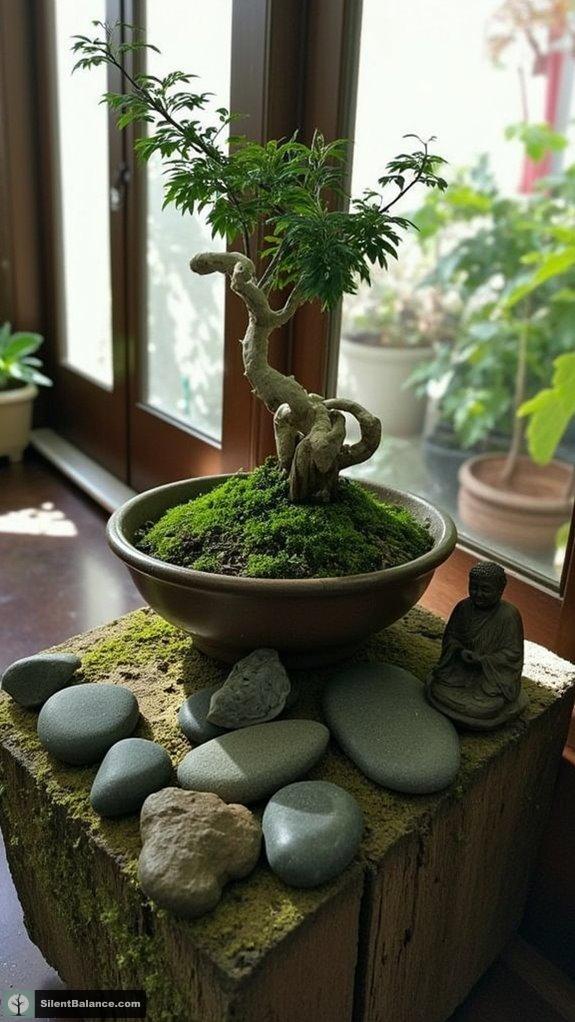
Creating an eye-catching bonsai display isn’t just about the tree—it’s all about the magical interplay of decorative elements that frame it.
Have you considered how pots and stands can transform your display? A ceramic pot can add a touch of tradition, while a sleek stone pot might bring in that modern flair.
And don’t forget, a well-chosen stand can elevate your tree, literally and figuratively, encouraging air circulation and attention.
Think about adding natural elements, too—smooth river stones or even a whimsical miniature Buddha can enhance your Zen vibes. Additionally, consider the optimal bonsai placement for maximizing sunlight exposure and promoting healthy growth.
Creating Miniature Zen Gardens
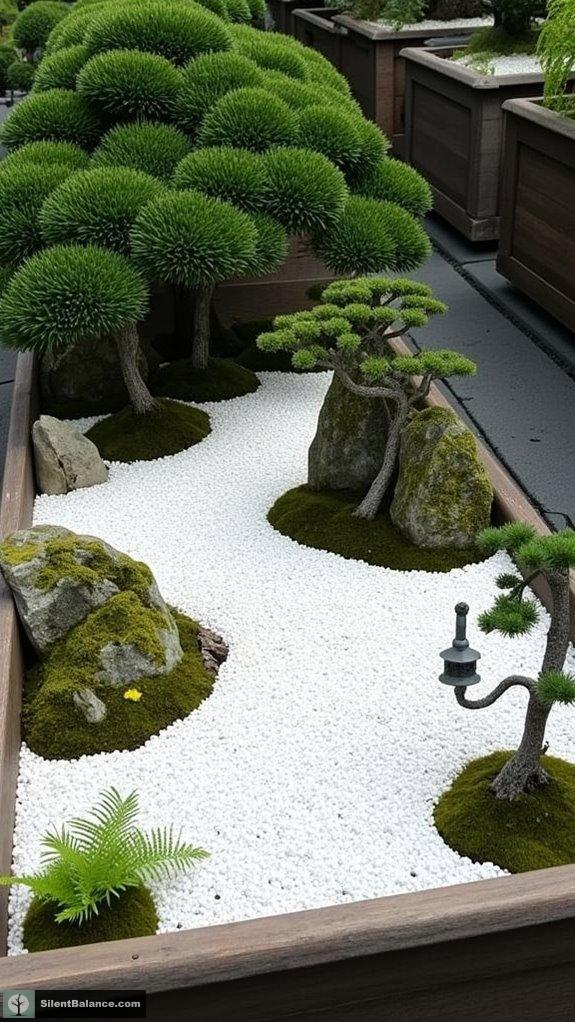
Envision this: a serene little world right on your tabletop, ready to whisk you away on a calming journey without leaving your home.
Creating your miniature Zen garden invites you to embrace simplicity and tranquility. Let’s break down the essentials:
| Element | Purpose |
|---|---|
| Rocks | Focal points symbolizing mountains |
| Gravel/Sand | Represents water, perfect for raking patterns |
| Moss/Ferns | Introduces soft texture, seasonal green hues |
| Wooden Containers | Supports portability and focus |
| Japanese Accents | Adds cultural authenticity in miniature forms |
Bonsai Forest Groupings

When you think about Bonsai forest groupings, it’s like crafting a miniature ecosystem right in your own garden—a delightful way to recreate the wonders of nature on a smaller scale.
I love selecting trees of varying heights, placing the tallest ones as focal points to draw the eye. It’s all about that layering effect, creating depth as smaller trees fill in around them. You’ll want about 7 to 15 trees for that lovely complexity.
Don’t forget about spacing; it’s key for airflow and that natural look.
Using pots with good drainage is essential, plus adding a layer of charcoal helps keep things fresh.
Isn’t the idea of a tiny forest just wonderfully enchanting? Let’s make some magic happen!
Key Care Techniques for Miniature Bonsai
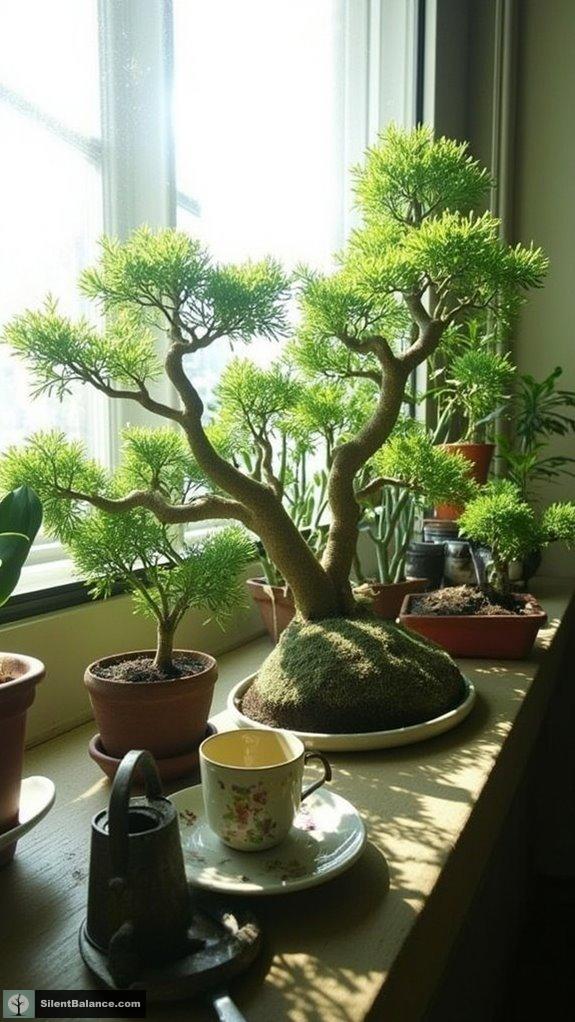
Caring for miniature bonsai is more than just a hobby; it’s an art form that requires your attention and flair!
Ever notice how under-watering can be a bonsai’s worst enemy? Keep an eye on that topsoil—water when it feels dry, but don’t drown your little friend!
Use a well-draining soil mix, like akadama, to keep roots happy. Bear in mind, repot every 2-3 years to refresh those nutrients!
Monthly fertilizing with diluted goodness keeps growth in check, and hey, don’t forget to mist for humidity, especially indoors!
Are you shaping your bonsai like a pro? With some careful pruning and wiring, your little tree will be the talk of the town!
Vibrant Flowering Bonsai Options
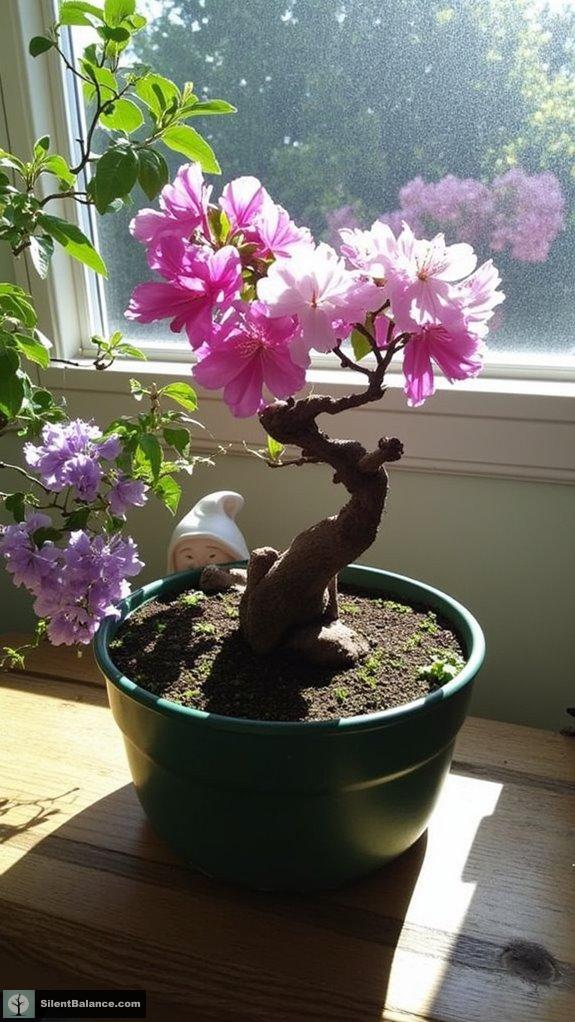
Bonsai enthusiasts know there’s something magical about a vibrant flowering bonsai that brings a splash of color and life to any space.
Take the Azalea, for instance—those delightful blooms in pinks, whites, and deep purples can light up your living room. They flower in spring and even fall if you’re lucky and attentive.
Or how about the Dwarf Wisteria? With its lavender flowers gracing branches yearly, it’s a showstopper, especially when you give it full sun.
And let’s not forget the charming little Crabapple, bursting with delicate blooms as a special treat over decades.
Which one speaks to you? Trust me, adding these flowering wonders to your collection will elevate your bonsai game and bring joy.
Incorporating Water Features
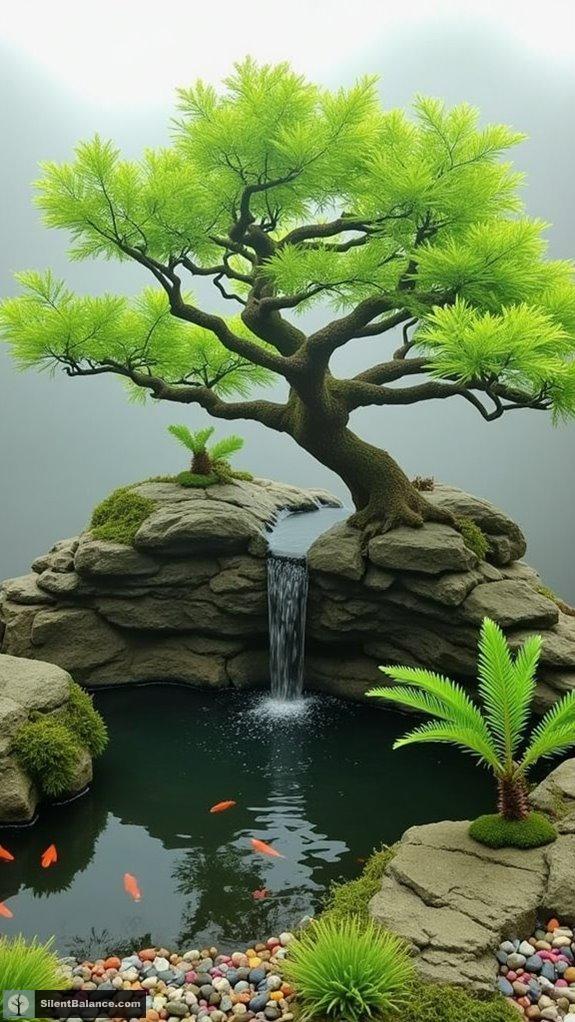
Adding water features to your bonsai setup can really take your passion to new heights—literally and visually! Envision the soothing sound of trickling water, drawing you closer to your green friends. It’s not just eye candy; water features like mini waterfalls and serene ponds create a thriving ecosystem around your bonsai, enhancing their essence and your enjoyment.
| Feature Type | Benefits | Visual Appeal |
|---|---|---|
| Small Waterfall | Aerates water, boosts oxygen | Dynamic water movement |
| Miniature Pond | Supports aquatic life | Reflective beauty |
| Submersible Fountain | Quiet ambiance | Charming led lighting |
| Wetland Filter Pond | Promotes clean water | Natural rock formations |
Aesthetic Accessories for Bonsai
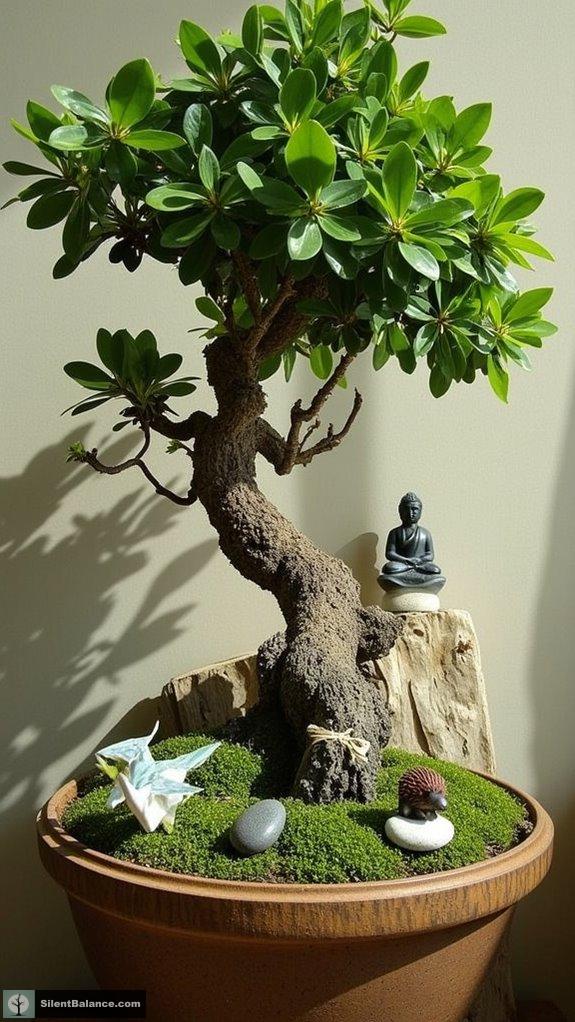
When it comes to enhancing your bonsai experience, incorporating aesthetic accessories can be an absolute game-changer.
Let’s talk figurines—how cute are those miniature hedgehogs or ceramic origami cranes nestled in the soil? They add personality and a dash of whimsy, don’t you think?
And don’t forget about those serene Buddha statues that elevate the zen vibe!
Artistic pots and stands can also make your bonsai stand out, whether you go for a sleek modern finish or a rustic charm.
Ever considered using natural elements? Weathered stones and moss layers create a true nature-inspired feel, perfect for your zen garden.
The right accessories not only amplify aesthetics but also allow a personal touch, merging style with your bonsai passion!
Indoor vs. Outdoor Bonsai Placement
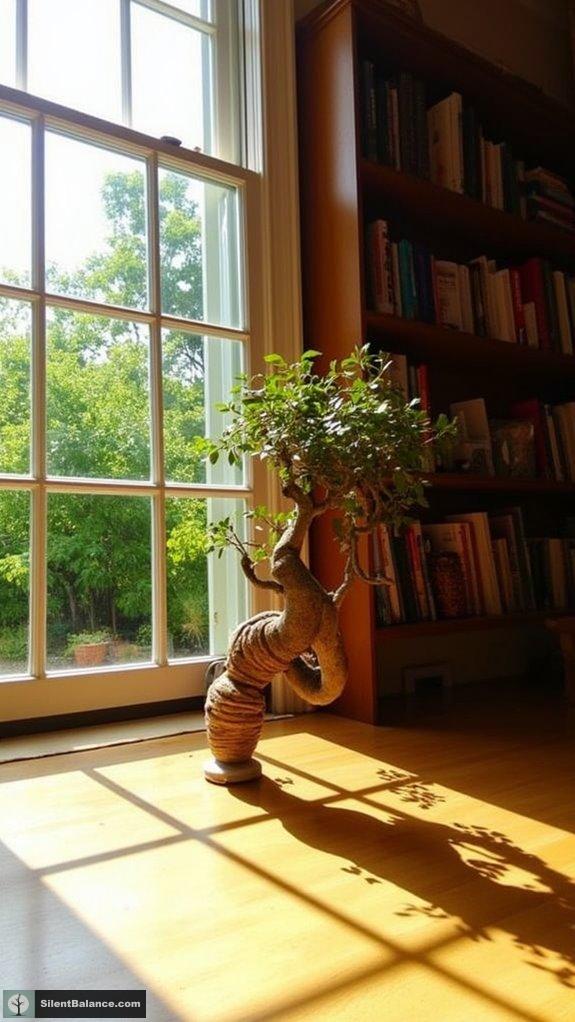
While I might wish for a magic wand that could instantly determine the best placement for your beloved bonsai, the truth is, the decision between indoor and outdoor placement is crucial for its health and happiness.
Indoor bonsai from the tropics crave warmth and bright light, so a sunny window is their happy place. Placing them near a southeast or west-facing window guarantees a sunny embrace.
But hey, outdoor bonsai are the real party animals! They thrive on natural light and seasonal changes.
However, don’t forget your tropical beauties need shelter from frost!
Bonsai Tree Symbolism
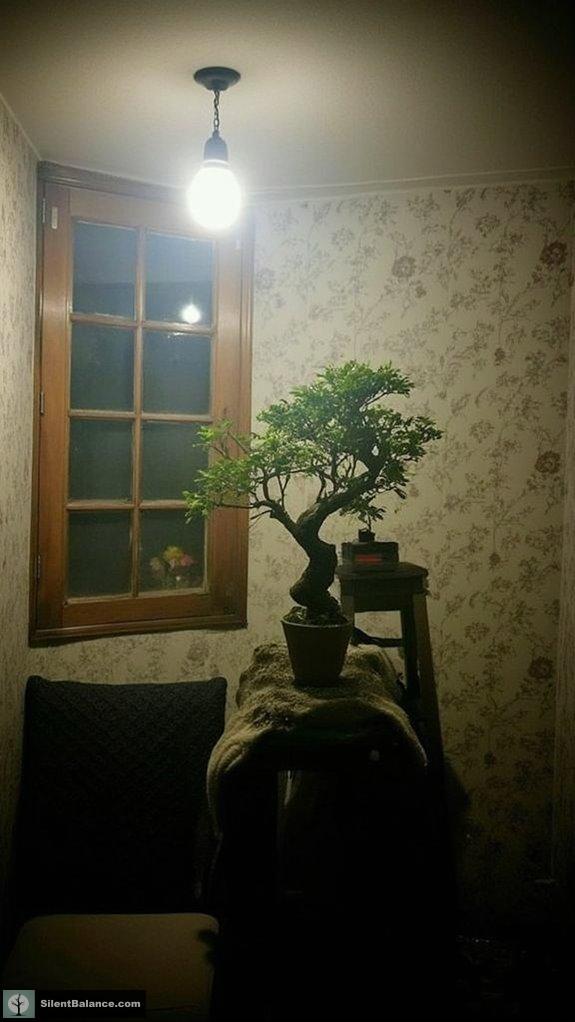
Bonsai tree symbolism runs deeper than just being a chic addition to your living room; it’s a vibrant tapestry woven from history, philosophy, and artistry.
These miniature wonders represent harmony and balance, embodying nature’s tranquility right in your space. They teach us patience through the loving care they require—after all, good things take time, don’t they?
Initially, bonsais symbolized status among elites but now, they foster mindfulness and a sense of calm.
Ever contemplated gifting one? Each species carries unique meanings, like the azalea, which whispers themes of love and beauty.
Envision gifting a companion tree to symbolize your relationship! Isn’t that just delightful?
With a bonsai, you’re not just adding greenery; you’re inviting peace and positivity into your life.
Tree Symbolism
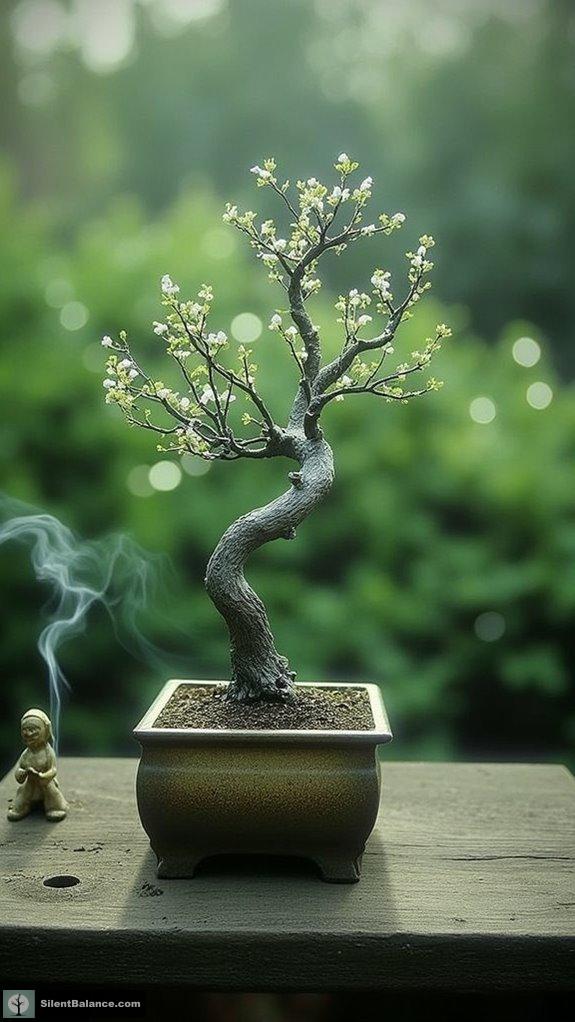
In exploring tree symbolism, you’ll discover a world where every branch and leaf tells a story, inviting us into a deeper understanding of nature.
Have you ever felt the grounding energy of an oak tree or admired the fleeting beauty of cherry blossoms? Isn’t it fascinating how cultures across the globe celebrate trees differently?
From the mighty baobab of Africa, symbolizing community strength, to the Celtic oak, embodying wisdom, these trees whisper tales of resilience and connection.
And let’s not forget the sacred acacia in Ancient Egypt—what a beautiful reminder of life’s cycles!
In bonsai culture, we cherish these meanings, infusing our tiny trees with symbolic depth.
Questions and Answers
How Do I Select the Best Bonsai Pot Size?
When I select a bonsai pot size, I consider the tree’s height and width, ensuring the pot’s dimensions reflect a harmonious balance. It’s essential to also think about root development and drainage needs.
What Tools Are Essential for Bonsai Maintenance?
For bonsai maintenance, I always reach for quality bonsai scissors, concave pruners, and branch cutters. They make shaping and pruning effortless. Plus, a good turntable keeps my work area organized and accessible during each session.
Can Bonsai Trees Thrive in Low Light Conditions?
Yes, bonsai trees can thrive in low light conditions. I’ve found species like Ficus and Jade do surprisingly well indoors. Just make sure to keep them warm and maintain humidity; they appreciate our care.
How Often Should I Repot My Miniature Bonsai?
I usually repot my miniature bonsai every 1–2 years when it’s young, but as it matures, I wait 3–5 years. I watch for signs like circling roots to know when it’s time.
What Are Common Pests Affecting Miniature Bonsai?
I’ve noticed a few common pests affecting miniature bonsai: aphids, mealybugs, and spider mites. They can wreak havoc, so I always keep an eye out for signs like leaf discoloration or sticky residue.
References
- https://www.bonsaiempire.com/inspiration/top-10/smallest-bonsai
- https://www.youtube.com/watch?v=u5a_r7qVQCI
- https://thursd.com/articles/miniature-bonsai-trees-that-color-and-enliven-spaces
- https://green-bonsai.com/blogs/bonsai-articles/the-10-most-popular-bonsai-trees-at-green-bonsai-in-2023
- https://thevietpotter.com/blogs/bonsai/top-figurines-for-bonsai-enhancement-2025
- https://md-eksperiment.org/en/post/20250419-mame-bonsai-the-magic-of-a-miniature-natural-world
- https://www.herbs2000.com/flowers/b_mame.htm
- https://www.youtube.com/watch?v=MZNzb9Kxe9U
- https://cincinnatibonsai.org/bonsai-tree-size-guide
- https://shohin-europe.com/case-stories/case-story-shimpaku-mame-bonsai/
- https://easternleaf.com/bonsai-trees/bonsai-by-classification/
- https://www.bonsaiempire.com/tree-species/
- https://forum.bonsaimirai.com/t/best-trees-for-indoor-bonsai/11363
- https://www.bonsaioutlet.com/beginner-bonsai-trees/
- https://thevietpotter.com/blogs/bonsai/bonsai-decoration-ideas
- https://bonsai2u.co.uk/how-to-display-bonsai-trees-indoors/
- https://www.bonsaioutlet.com/bonsai-display-tables-stands/
- https://www.bonsaiempire.com/blog/bonsai-stand
- https://www.youtube.com/watch?v=6UDD75xMKCQ
- https://www.mayberryzengardens.com/post/zen-garden-designs
- Top 10 Bonsai Tree Designs for Miniature Home Greenery - September 5, 2025
- What Are the Easiest Bonsai Tree Species for Minimal Care? - September 5, 2025
- Best Bonsai Tree Species for Outdoor Seasonal Climates - September 5, 2025

